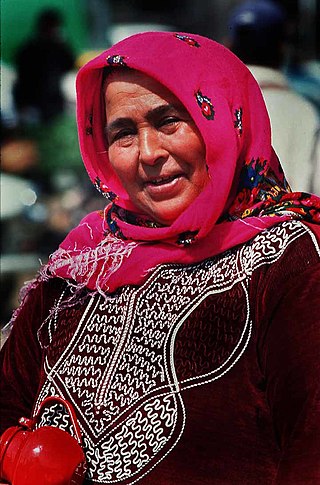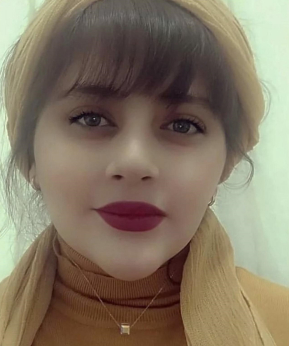
In modern usage, hijab generally refers to various head coverings conventionally worn by many Muslim women. It is similar to the tichel or snood worn by Orthodox Jewish women, certain headcoverings worn by some Christian women, such as the mantilla, apostolnik and wimple, and the dupatta worn by many Hindu and Sikh women. Whilst a hijab can come in many forms, it often specifically refers to a scarf wrapped around the head, covering the hair, neck and ears but leaving the face visible. The use of the hijab has been on the rise worldwide since the 1970s and is viewed by many Muslims as expressing modesty and faith; it has also been worn for purposes of adornment. There is a consensus among Islamic religious scholars that covering the head is either required or preferred, though some Muslim scholars and activists point out that it is not mandated.
Throughout history, women in Iran have played numerous roles, and contributed in many ways, to Iranian society. Historically, tradition maintained that women be confined to their homes to manage the household and raise children. During the Pahlavi era, there was a drastic social change towards women's desegregation such as ban of the veil, right to vote, right to education, equal salaries for men and women, and the right to hold public office. Women were active participants in the Islamic Revolution. Iran's constitution, adopted after the Islamic Revolution in 1979, proclaims equality for men and women under Article 20, while mandating legal code adhering to Sharia law. Article 21 of the constitution as well as a few parliament-passed laws give women rights such as being allowed to drive, hold public office, and attend university but not wearing a veil in public can be punished by law; and when in public, all hair and skin except the face and hands must be covered. However, this is often not enforced; notably in recent years, Iranian women have started a number of groups to rebel against the government's oppressive policies and reclaim their independence and rights.
During the late 20th and early 21st centuries in Iran, women's rights have been severely restricted, compared with those in most developed nations. The World Economic Forum's 2017 Global Gender Gap Report ranked Iran 140, out of 144 countries, for gender parity. In 2017, in Iran, females comprised just 19% of the paid workforce, with seven percent growth since 1990. In 2017, the Georgetown Institute for Women, Peace and Security (WPS) Index ranked Iran in the bottom tercile of 153 countries. Compared to other South Asian regions, women in Iran have a better access to financial accounts, education, and cellphones. Iran was ranked 116, out of the 153 countries, in terms of legal discrimination against women.

Various styles of head coverings, most notably the khimar, hijab, chador, niqab, paranja, yashmak, tudong, shayla, safseri, carşaf, haik, dupatta, boshiya and burqa, are worn by Muslim women around the world, where the practice varies from mandatory to optional or restricted in different majority Muslim and non-Muslim countries.

Sex segregation in Iran encompasses practices derived from the conservative dogma of Shiite Islam currently taking place in Iran. Most areas of the country are segregated by sex, except universities. In many cities, there are women parks. Sex segregation prohibits males from viewing females, and age of consent laws do not exist, as all sexual activity outside marriage is illegal. UN experts have denounced Iran for enforcing gender apartheid.

On 8 January 1936, Reza Shah of Iran (Persia) issued a decree known as Kashf-e hijab banning all Islamic veils, an edict that was swiftly and forcefully implemented. The government also banned many types of male traditional clothing.

Sadaf Taherian is an Iranian model and former actress. She has had appearances in Iranian movies and television. After leaving the country, Taherian posted unveiled images of herself on Facebook and Instagram that were denounced by Iran's ministry of culture and Islamic guidance.

The Guidance Patrol or morality police is an Islamic religious police force and vice squad in the Law Enforcement Command of the Islamic Republic of Iran. The Guidance Patrol enforce Sharia–Islamic law—per laws in Iran; this is most often the enforcement of Islamic dress code, such as ensuring women in the country wear hijabs. The Guidance Patrol was formed in 2005 as a successor organisation to the older Islamic Revolution Committees, and reports to the Supreme Leader.
The Girls of Enghelab protests are protests against the compulsory hijab in Iran, part of the wider Iranian Democracy Movement. The protests were inspired by Vida Movahed, an Iranian woman known as the Girl of Enghelab Street, who stood in the crowd on a utility box on Enghelab Street in Tehran on 27 December 2017 during the 2017–2018 Iranian protests who tied a white headscarf, to a stick, and waved it to the crowd as a flag. She was arrested on that day and was released temporary on bail a month later, on 28 January 2018. Some people interpreted Movahed's action as being based on Masih Alinejad's call for White Wednesdays, a protest movement that the presenter at VOA Persian Television started in early 2017. Other women later re-enacted her protest and posted photos of their actions on social media. These women are described as the "Girls of Enghelab Street" and the "Girls of Revolution Street" in English sources. Some of the protesters however claim that they were not following Masih Alinejad's call. The protests intensified in 2022 due to the death of Mahsa Amini.
Vida Movahed, more commonly known as Vida Movahed, is an Iranian human rights activist, protester, and women's rights activist who is considered the initiator of the Girls of Enghelab movement. On December 27, 2017, on the Enghelab Street in Tehran, she symbolically took her white headscarf off to protest against the mandatory hijab in Iran. Subsequently, her picture was published as "The Girl of Enghelab Street".

Fashion in Iran has a cultural and economic impact on the county of Iran. During the Pahlavi era around the mid-1930s, Western fashion was introduced to the country and greatly influenced women's style. After the Iranian Revolution in 1978–1979, the hijab has become compulsory, which impacted the creation of clothing style.

On International Women's Day on March 8, 1979, a women's march took place in Tehran in Iran. The march was originally intended to celebrate the International Women's Day, but transformed into massive protests against the changes taking place in women's rights during the Iranian revolution, specifically the introduction of mandatory hijab (veiling), which had been announced the day before. The protests lasted for six days, from 8 March to 14 March 1979, with thousands of women participating. The protests were met with violence and intimidation by pro-Khomeini Islamist forces.
#LetUsTalk is a campaign against silencing criticism of the Islamic law and especially hijab in the West through accusations of Islamophobia. This campaign has started when a letter written by Dr Sherif Emil—a Canadian Children’s surgeon—and published in the Canadian Medical Association Journal, in which he criticizes promotion of hijab as a symbol of diversity, was retracted due to the accusations of Islamophobia. Many middle eastern women, including Iranians and Afghans, have shared their lived experience and stories of being oppressed by the Islamic law using this hashtag. The campaign defends the right of criticizing Islam and protests the censorship of such criticism with the accusations of Islamophobia.

Melika Balali is an Iranian-born Scottish wrestler, who won the British championship gold medals. Besides her wrestling career, she is a poet and painter who talks about women's rights in her work.

On 16 September 2022, 22-year-old Iranian woman Mahsa Amini, also known as Jina Amini, died in a hospital in Tehran, Iran, under suspicious circumstances. The Guidance Patrol, the religious morality police of Iran's government, arrested Amini for allegedly not wearing the hijab in accordance with government standards. The Law Enforcement Command of the Islamic Republic of Iran stated that she had a heart attack at a police station, collapsed, and fell into a coma before being transferred to a hospital. However, eyewitnesses, including women who were detained with Amini, reported that she was severely beaten and that she died as a result of police brutality, which was denied by the Iranian authorities. The assertions of police brutality, in addition to leaked medical scans, led some observers to believe Amini had a cerebral hemorrhage or stroke due to head injuries received after her arrest.

Shiva Amini is an Iranian women's futsal player formarly playing for Iran national team and Matin Varamin. She immigrated from Iran in 2017 and currently lives in Switzerland. Since 2009, she was no longer included in the national team because she had published pictures of herself without hijab during one of her foreign trips and had played futsal with boys. Finally, the Iranian Islamic Republic regime's harassment forced her to leave Iran and seek asylum in Switzerland. Today, she is a youth and children's futsal coach in Switzerland.

The ongoing Mahsa Amini protests broke out following the death of Mahsa Amini while she was under arrest by the Guidance Patrol of the government of the Islamic Republic of Iran. Reactions to her death and the following crackdown on protestors by law enforcement are both domestic and international.

Ammāmeparāni, often referred to as Turban knocking in English, refers to a protest action by Iranians in which they throw the turban off the head of a mullah in order to express their disgust with the Shia clergy and therefore insult it. The action is normally done through the protester running past the subject, knocking the headdress while continuing to run off to avoid capture. During the Mahsa Amini protests in Iran of 2022, people would take videos doing this action, publishing them on social media, resulting in a brief popularization of the protest method.
After the 1979 Iranian Revolution, it became compulsory for women to cover their hair in Iran with a scarf that covered the hair and neck, but not the face. Hijab was seen as a symbol of piety, dignity, and identity for Muslim women.
A manteau and pants is a combination of a manteau and pants worn together. This ensemble became common in Iran following the Islamic Revolution, particularly due to the implementation of mandatory hijab. Manteau and pants come in various styles, including formal wear for parties, casual everyday wear, school uniforms, and office attire.















